NFPA inspections of water storage tanks for fire protection
In this installment of QRFS’ series on the inspection of commercial automatic fire sprinkler systems, we detail the National Fire Protection Association (NFPA) requirements for fire sprinkler tank inspections.
Tanks supply water to fire sprinkler systems, in part or in whole. They are often used in rural areas to serve as the entire supply of water, and are also used in structures that have a municipal water supply but must deal with high-demand fires or special circumstances. These include warehouses with high-piled storage, aircraft hangers, and high-rise buildings located in earthquake-prone areas that need a secondary water supply.
The amount of water needed to control or suppress a fire is based on the duration and demand required by NFPA 13: Standard for the Installation of Sprinkler Systems. In many cases, a building will require several thousand or hundreds of thousands of gallons to supply a fire sprinkler system. This is where tanks that augment the main water source come into the picture.
The tank installation standard, NFPA 22: Standard for Water Tanks for Private Fire Protection, permits tanks to be made of steel, wood, concrete, or coated fabrics, and categorizes tanks in three types:
- Elevated tanks on towers or building structures
- Tanks at or below grade (suction tanks)
- Pressure tanks
This video shows the installation of a below-grade tank:
After a tank is installed, connected to the fire sprinkler system, and is in operation, Chapter 9 of NFPA 25: Standard for the Inspection, Testing, and Maintenance of Water-Based Fire Protection Systems covers its fire sprinkler tank inspection requirements. At the beginning of the chapter is a table that summarizes the inspections, testing, and maintenance; most of the inspections are external, but the list does include some internal items that need to be looked at occasionally.
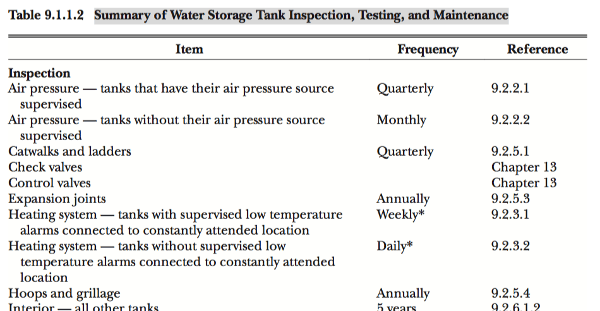
Water levels are critical for fire sprinkler systems
Tanks must be sized to provide enough water to control or suppress a fire in the building, and water levels must be checked and maintained. The water level may be indicated by a device or a visual mechanism. NFPA inspection requirements are as follows:
From the 2017 Edition of NFPA 25
9.2.1.1* The water level in tanks equipped with supervised water level alarms that are supervised in accordance with NFPA 72 shall be inspected quarterly.
9.2.1.2 The water level in tanks not equipped with supervised water level alarms connected to a constantly attended location shall be inspected monthly.
The supervised water level alarm is an electric or electronic device that detects changes in the level. When the water level falls below the fill mark, a signal (supervision) will be sent to the fire alarm panel or at a constantly-attended location (a guard shack, an alarm monitoring service, etc.). This electric supervision means that the water level in a tank must only be visually inspected every quarter. If a tank just has a visual indicator, such as a sight glass or a float (such as a pully-style indicator shown below), the inspection frequency increases to monthly.
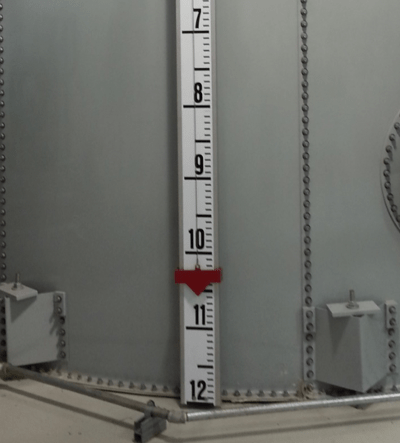
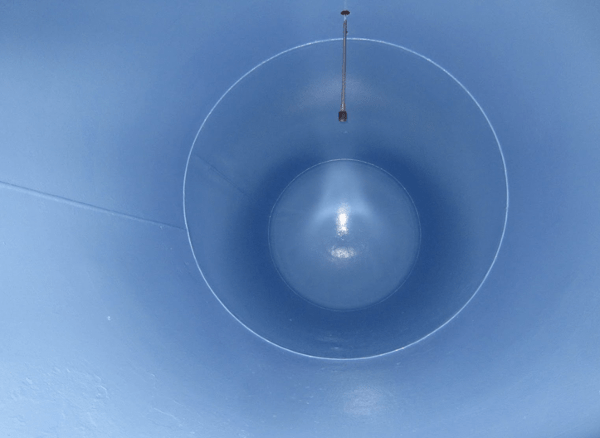
Water cannot freeze in fire protection tanks
One of the biggest challenges in maintaining fire sprinkler systems in northern climates is protecting water (and other agents) from freezing. Due to the size of most tanks, they are usually located outdoors. All NFPA water-based fire protection standards (NFPA 13, NFPA 14, NFPA 25, etc.) conservatively increase the water freezing threshold to 40 degrees F, instead of 32 degrees F. This higher temperature is required due to the stagnant nature of water in fire protection systems. NFPA 25 inspection requirements for maintaining 40 degrees F are as follows:
From the 2017 Edition of NFPA 25
9.2.2.1 Tank heating systems installed on tanks equipped with low water temperature alarms supervised in accordance with NFPA 72, connected to a constantly attended location shall be inspected quarterly during the heating season.
9.2.2.2 Tank heating systems without a supervised low temperature alarm connected to a constantly attended location shall be inspected daily during the heating season.
9.2.3.1 The temperature of water in tanks shall not be less than 40°F (4.0°C).
9.2.3.2 The temperature of water in tanks with low temperature alarms supervised in accordance with NFPA 72, connected to a constantly attended location shall be inspected and recorded quarterly during the heating season when the mean temperature is less than 40°F (4.0°C).
9.2.3.3 The temperature of water in tanks without low temperature alarms connected to a constantly attended location shall be inspected and recorded weekly during the heating season when the mean temperature is less than 40°F (4.0°C).
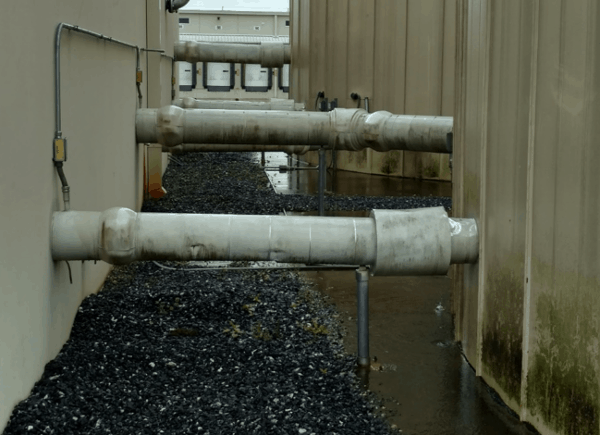
Heating systems for tanks vary widely and include steam, gas-fired, oil-fired, coal-burning, electric, steam coil, and solar water heaters that are permitted by NFPA. The objective is to keep water from freezing and creating ice that blocks or plugs the fire sprinkler system. During cold weather, the heating system for the tank needs to be inspected either:
- Daily, if there is no electric supervision, or
- Quarterly, if the tank is supervised with a low water temperature signal sent to a constantly attended location.
Inspections during the heating season (typically Oct-May in the northern U.S. and Canada) need to verify and record that the water is at least 40 degrees F. Frozen fire sprinkler systems will not protect the building or its occupants from fire, of course.
Fire sprinkler tank inspections: Looks matter … walking the outside, kicking the tires
The exterior visual inspection of the tank is one of the easier, non-technical duties of onsite facilities personnel. If something looks bad, chances are it will trigger the need for some maintenance. Remember, tanks come in all types, shapes and sizes. Some tanks are supported by steel structures that are susceptible to foundation settling or shifting or everyday rust. Some tanks are wood and can experience rot, while for some concrete tanks, cracking is a concern. NFPA 25 outlines the following inspections:
From the 2017 Edition of NFPA 25
9.2.4.1* The exterior of the tank, supporting structure, vents, foundation, and catwalks or ladders, where provided, shall be inspected quarterly for signs of obvious damage or weakening.
9.2.4.2 The area surrounding the tank and supporting structure, where provided, shall be inspected quarterly to ensure that the following conditions are met:
(1) The area is free of combustible storage, trash, debris, brush, or material that could present a fire exposure hazard.
(2) The area is free of the accumulation of material on or near parts that could result in accelerated corrosion or rot.
(3) The tank and support are free of ice buildup. (4) The exterior sides and top of embankments supporting coated fabric tanks are free of erosion.
9.2.4.3 Expansion joints, where provided, shall be inspected annually for leaks and cracks.
9.2.4.4 The hoops and grillage of wooden tanks shall be inspected annually.
9.2.4.5 Exterior painted, coated, or insulated surfaces of the tank and supporting structure, where provided, shall be inspected annually for signs of degradation.
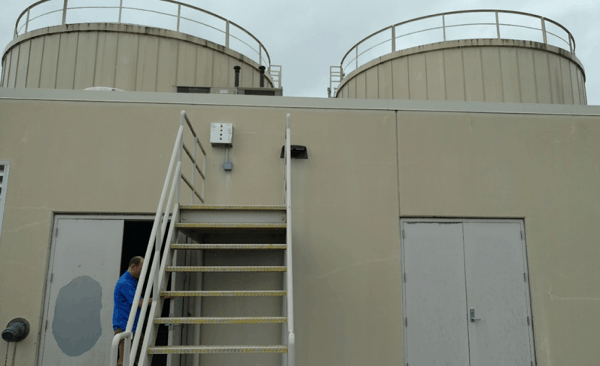
Exterior painted and coated surfaces need to be inspected annually to make sure that the tank surface and surrounding structure are still being protected from corrosion. If the tank has a coating that consists of exterior insulation, the insulation needs to be inspected annually to make sure that it is in place and continues to protect the water from freezing.
On a quarterly basis, the supporting structure of every tank must be inspected, regardless of whether it is installed inside or outside. The inspection needs to verify that the structure does not appear to be weakening or damaged. The following items have to be checked:
- The area is free of combustible storage, trash, debris, brush, or material that could burn and potentially damage the tank. Some wildland interface areas, such as in Colorado, Idaho, and California have strict codes and standards for keeping combustibles, vegetation, and landscaping away from tanks and occupied buildings.
- The area is free of material that could accelerate corrosion or rot on the tank or its supports. Removing any combustibles and standing water are common items to look for.
- The exterior sides and top of embankment-supported, coated-fabric tanks are free of erosion. Heavy rains and hill slopes without vegetation can erode the soil around the tanks.
- During freezing weather, the inspection needs to include looking for ice build-up and evidence that the water in the tank might be freezing.
Looking inside tanks
The interior of a tank contains the water for the fire sprinkler system, of course, which can complicate inspection. Nevertheless, while many interior issues become apparent on the exterior if left unchecked for a long time, it is critical to have a look inside of tanks to catch issues early. The inspection requirements listed below are typically done by a qualified inspector or contractor:
From the 2017 Edition of NFPA 25
9.2.5.1.1* The interior of steel tanks without corrosion protection shall be inspected every 3 years.
9.2.5.1.2* The interior of all other types of tanks shall be inspected every 5 years. 9.2.5.2 Where interior inspection is made by means of underwater evaluation, silt shall first be removed from the tank floor.
9.2.5.3 The tank interior shall be inspected for signs of pitting, corrosion, spalling, rot, other forms of deterioration, waste materials and debris, aquatic growth, and local or general failure of interior coating.
9.2.5.4 Steel tanks exhibiting signs of interior pitting, corrosion, or failure of coating shall be tested in accordance with 9.2.6. 9.2.5.5* Tanks on ring-type foundations with sand in the middle shall be inspected for evidence of voids beneath the floor.
9.2.5.6 The heating system and components including piping shall be inspected.
9.2.5.7 The anti-vortex plate shall be inspected for deterioration or blockage.
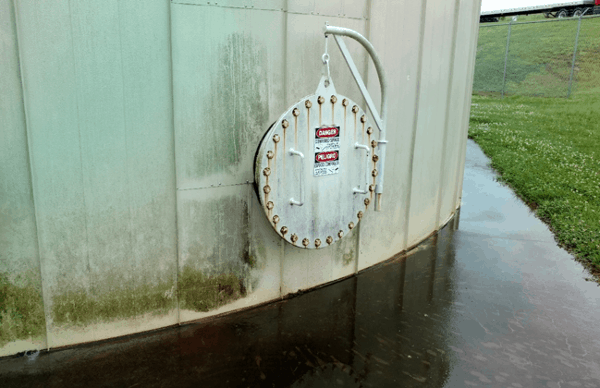
The frequency of the interior inspection depends on the material that the tank is constructed of and its corrosion protection. If the tank is made from steel and does not have any corrosion protection, such as paint or a corrosion-resistant coating, then the inspection needs to be done every three years. For concrete and wood tanks, and steel tanks with corrosion protection, the internal inspection needs to be done every five years.
The National Fire Sprinkler Association has an online interactive training course – Inspection of Pumps and Tanks ITM Series – that is a great resource for tank inspectors. In it, former NFSA Vice President of Engineering Ken Isman discusses what’s needed for an interior inspection:
In order to conduct the interior inspection of the tank, you either have to drain the tank completely of water, or you need to send a diver into the tank with sufficient lighting to see the tank’s condition. If you choose to send a diver into the tank, the diver needs to be certified to dive in confined spaces. This is more than just a certification to dive in an open body like an ocean. Diving safely in confined spaces takes additional knowledge and training. Make sure to conduct inspections safely at all times. When the diver gets down to the bottom of the tank, they may need to move a layer of silt in order to complete the inspection.
Once inside the tank – whether it’s full or empty – visually inspect the following:
- Check the anti-vortex plates for corrosion and damage.
- Look for signs of loss of bottom of tank support (some tanks rest on a ring-type foundation with the bottom of the tank supported by sand or other material).
- Check the heating system.
Again, all of these inspection items are typically done by a qualified inspector.
This concludes the NFPA inspection requirements for fire safety tanks. “Tanks” for reading!
Be sure to check out our previous blogs in the series:
Part one: The annual visual inspection of sprinkler heads
Part two: The annual visual inspection of pipe and fittings
Part three: The inspection requirements for fire pumps
Part four: The inspection of signs, gauges, and alarms
Part five: The inspection of fire sprinkler system valves
If you need to buy parts for your commercial fire sprinkler system, check out QRFS’ selection of commercial fire sprinkler heads, cover plates, escutcheons, and other components and tools, or just use the search bar at the top of the page to find what you’re looking for. If you have any questions about commercial fire sprinklers or need help finding an item, give us a call at 888.361.6662, comment below, or fill out our contact form and we’d love to assist.



we have a metal roof on our tank and an inspection we just found a hole near the edge of the tank. can we repair (weld) a patch over the hole.
Aaron — Thanks for reaching out. For code questions like this, we recommend submitting your question through QRFS Ask A Pro. Click the link to submit your question with some information about your building or system, and a fire protection professional will provide a detailed answer based on standards and codes. Our pros include AHJs, contractors, engineers, and code experts with 150+ years of combined experience!
It was helpful when you explained that concrete tanks need to be inspected a minimum of every 5 years. My uncle is looking into getting a concrete water tank installed to use in the fire system of his manufacturing plant. I’ll share this info so he’s aware of regulations when making a plan for maintaining the concrete water tank.
Given information’s are very useful and will be taken note . one of my other concern is to clean these fire tanks what would be frequency period to be maintained to clean tanks , is this bi annually or quarter!
If you can give the clause references, would also be helpful.
Jadesh — thanks for reaching out. For code and standard questions like this, we recommend submitting your question through QRFS Ask A Fire Pro. Click the link to submit your question with some information about your building or system, and a fire protection professional will provide a detailed answer based on standards and codes. Our pros include AHJs, contractors, engineers, and code experts with 150+ years of combined experience!
My client built his 2 storey house of less than 10,000 sq. ft. in 2000. He has a 300 gallon tank to supply the sprinkler fire suppression system. There is no automatic refill system for the 300 gal tank. I was told by a local pump and tank dealer (he deals mostly in water well systems) that the house needs enough water in the tank to supply two nozzels with water for 10 minutes, thus allowing the occupants enough time to escape the house. He also says that a continuous flow system could would wreck havoc by flooding the house. Is this OK. The house is located on Vashon Island in unincorporated King County, Wasgington
Bill — The 10-minute rule is a minimum that ensures there will be enough water to control a fire—there are calculations involved to match the water supply (gallons) in a tank to the pressure and flow from sprinklers to ensure this standard is met.
As for a continuous flow system, MOST residential sprinkler systems are continuous flow, as they tap the pressurized municipal water supply. To mitigate water damage, the water needs to be shut off (or the sprinklers stopped with a tool) once a fire is under control.
There are trade-offs to either approach—tank or continuous supply—with the cons of a tank being you have to check the water levels and maintain them, etc. But either approach is fine, as long as it follows NFPA rules.
i am sorry… the question, is allow storage Fire water tank (concrete material) is open wiith Height 3 meter
Permadi — You’ll want to review NFPA 22 rules; however, an open-topped fire protection tank presents the chance for sediment to get into the system, causing blockages and/or accelerating corrosion.